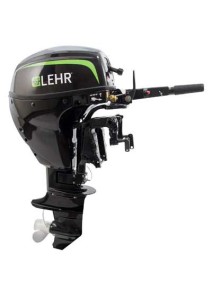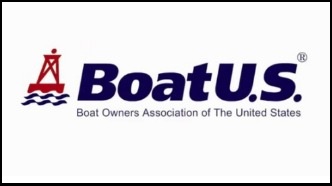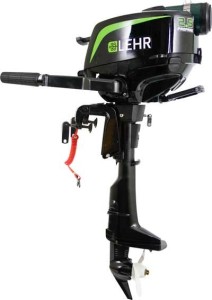This article originally published By Chris Edmonston | December 2013 | Boat US | LINK
Foundation Findings #52: Our team takes a close look at how environmentally friendly outboard motors perform.
Remember the days when you could hear an outboard long before you could see it, and it was almost always accompanied by a blue cloud of smoke? Fortunately, for us and the environment, today’s modern outboards put those experiences in the dustbin of time. In recent years, manufacturers have been putting out more and greener choices in outboards than ever before. Even more traditional gas motors meet environmental standards that were out of reach not that long ago, and now manufacturers are adding alternative fuels to the mix.
To find out how the new outboards performed, we took several of them out on a variety of boats in Annapolis Harbor. We used three commonly available brands (Mercury, Lehr, and Torqueedo) using three different fuels (gas, propane, and electricity), and sent them out with boaters who had a wide range of experience. The boats we used were a 12-foot jon boat, a 10-foot rigid hull inflatable, and an 18-foot daysailer. Parts of our testing were empirical, but we also wanted to find out the operators’ impressions of how the engines were to use. As with all Foundation Findings, we try to show how boaters will operate the products in the real world. We aren’t trying to pick a winner — any of these engines could be just what you’re looking for — but there are more considerations before you buy than just, “How fast does it go?”
Gasoline
If you’ve used an outboard, the chances are it was powered by gasoline; that was the case with all of our test drivers – mostly our Foundation staff, and our BoatUS Magazine editors. We used two different Mercury Marine outboards, a 2.5 hp model ($899), and a 9.9 hp ($2,239), both four-strokes. There were differences between the two — the smaller model has a built-in, non-removable fuel tank, and lacks reverse gear (you have to swing the whole engine around to back up). The 9.9 was considerably quieter than the 2.5 because its exhaust runs through the propeller hub, rather than discharging higher up like the smaller engine.
Gasoline engines are the industry standard, and our drivers had
high confidence in the Mercury outboards.
Operators liked the small size and weight of the 2.5, for mounting and storage, and found the operation straightforward (although backing down took a little getting used to). The 9.9 was much quieter and had less vibration than the 2.5. The locking tiller on the 9.9 was great on the sailboat, and operators liked having all the controls on the tiller. Executive editor Mike Vatalaro was a big fan of the larger Merc: “It was smooth and quiet. I had confidence in it. It made me want to own a small boat.”
Propane
Propane engines are similar enough to gasoline outboards that there are conversion kits available to switch smaller, gas-powered outboards over to propane use. Why do that? Propane burns 50 times cleaner than gas, it’s domestically produced, and propane engines generally start more easily than a similar gasoline engine, because the fuel is pressurized. Propane is also easier to refuel than gasoline — just screw the tank in, no sloshing around at the fuel dock — and there are no issues with water (or ethanol) in your fuel or the long-term storage of fuel.

The propane-powered Lehr engines are clean and efficient, without being too unfamiliar.
The propane engines we used were built by Lehr, who are the first manufacturer to build an outboard specifically for propane. As with the Mercury outboards, we tried out the 2.5 and 9.9 hp models. The smaller model used a one-pound camp-stove-style canister, with the option of adding a larger tank. The internal fuel line was a little short, making it difficult to screw in the fuel canister (and a little painful when the engine was hot). The small Lehr was the noisiest engine we used, and vibrated more than the other outboards, but it also drove the boats faster than the same-sized Mercury. The larger Lehr, which our drivers preferred, was much quieter than the 2.5 (but still noisier than its gasoline counterpart). “The Lehr is about as close to a traditional outboard you can get, but without the hassles of choking the motor, mixing fuel, and pouring gas of traditionally fueled outboards,” said Ted Sensenbrenner of the Foundation. “Most of us who’ve used a traditional gas grill expect a small change in flame height when the control knob is turned from min to max. But when you twist the throttle on the Lehr outboard, the range is surprisingly broad.” The 9.9’s shift lever, placed right next to the pull cord, caused a few busted knuckles when starting the engine, but it was smooth-shifting and powerful, and had excellent acceleration.
Electric
Unlike the electric trolling motors you may be familiar with, Torqueedo designed their outboards to be the primary propulsion for your boat. Torqueedo uses a different calculation to measure the engine’s power than the gas and propane engines (propulsive power at the prop, rather than “shaft horsepower”), so output comparisons are difficult. We used a small Travel 1003 model, which puts out 68 pounds of thrust, and a larger Cruise 2.0 model, which will make 115 pounds of thrust. At $1,999 and $3,299, respectively, they were the most expensive motors we used, but manufacturers contend that if you use the motors often, they’ll compare favorably to a gas engine over their life cycle. The Travel 1003, as its name suggests, breaks down into smaller pieces for ease of storage. The Cruise model is intended to be remotely controlled (also an option on the smaller engine), and would be best suited to a small sailboat or as a kicker on a fishing boat, so we only tried it on the sailboat.
The emission-free Torqeedo electric motors were the quietest
our drivers tested, but caused “range anxiety” for some.
The Torqueedos are emission-free during operation, although there are likely emissions for the power source used to charge them. Both engines are waterproof to a depth of one meter, and both display current speed, range at that speed, and battery life. That’s good, because battery life was a concern to our operators. With the smaller Torqueedo, our consumer editor Charles Fort said, “There’s some anxiety about the range, but with the gauge right there, at least you know what the range is. You don’t have to guess.” Operators did manage to drain the battery of the Travel 1003 in less than an hour at wide-open throttle, and it requires 15 hours to fully charge. The only options for more power on the smaller outboard are a second battery, which costs $700, or a solar charger, which can prolong a trip, but won’t charge fast enough to prevent draining the battery. Fort found the whirring noise of the smaller engine annoying, but said, “Apart from the range anxiety and a little noise, this was a great engine.” On the larger outboard, operators slowed down rather than risk depleting the battery (at slow speeds it drained slowly). Fort said there was much less worry about the range with the larger Torqueedo. “I’d have no problem with that on a daysailer,” he said. “It had really good throttle response, and at low speed was almost completely silent. You could hear the water going past the hull.” Both engines are torque-y, and vibration-free, and start easily at the touch of a button.

